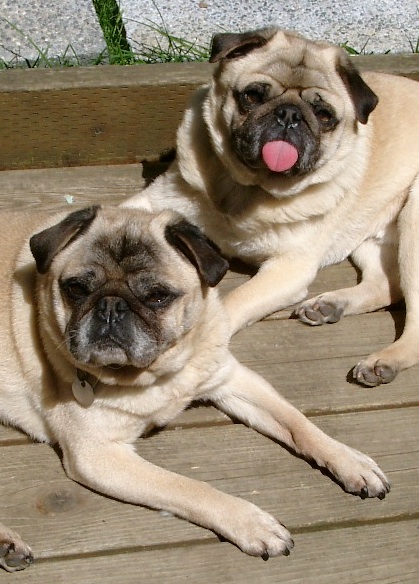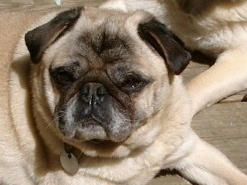
pugs, l
(article, Jim Dixon)
[%pageBreakSettings nobreak=true] The recent recalls of millions of pounds of moist pet food containing wheat gluten, spurred by the kidney failure and death of cats and dogs across the country, exposed one of the dirty secrets of the industry. From a single plant in Canada, the formerly relatively unknown Menu Foods was churning out pet food and selling it under dozens of different names, from high-end labels like Eukanuba and Iams to budget house brands for the Winn Dixie, Save-A-Lot, and Publix supermarket chains. [[block(sidebar). h1. Homemade dog treats Check out Laura Grace Weldon's ideas for making dog treats at home. ]] Now, other companies are also recalling their pet food. It's unclear what, exactly, has contaminated the food; the New York Times has reported that both a rat poison and a fertilizer have been detected in laboratory tests. But whatever the outcome, pet owners are justifiably worried about their animals’ food supply. Our household includes a pair of pugs. But Marty and Carlo weren’t affected by the recall, and it wasn’t just because they lived on dry kibble. For the past five years, I’ve been making their food from ingredients available at the corner supermarket. [[block(sidebar). h1. Recalls, books, and food for cats Want to know whether pet food you've bought recently should be scrapped? Check out the FDA's special pages about the pet food recall. Care to become your pet's chef? Read this article on the latest cookbooks for pets. If you are feeding a cat, you might want to read this post and the comments that follow on the Ethicurean blog. ]] I wasn’t motivated by a need to improve their diet. The boys had been eating one of the better brands of kibble and, according to the vet, were doing just fine. But Carlo, the younger of the pair, was prone to a mild form of canine dermatitis. Every few weeks he’d break out in a hot pink rash, and we’d slather him with an expensive prescription ointment. It got rid of the rash, but it wasn’t a cure. Our vet told us that the rash was a self-inflicted bacterial infection that resulted from Carlo licking himself too much. She said he probably had a food allergy that made him itch. Great, we thought. How do we deal with that? It turns out that corn, soy, and wheat, common ingredients in commercial dog food, are also common dog allergens. Switching to a kibble made from rice helped a little, but didn’t solve the problem entirely. After yet another session with the skin ointment, I started thinking seriously about finding something better. And then I landed on the idea to make it myself. [%image pugs float=right width=350 caption="The author's pet pugs, Marty and Carlo." credit="Photo courtesy Jim Dixon"] I learned that a balance of protein, grain, and plant foods is necessary to meet canine nutritional requirements. The grain for our dogs, obviously, would be rice. Carrots provided plant fiber and complex carbohydrates. Finding a source of protein took longer, since it needed to be both affordable and relatively easy to prepare. One day at Safeway, while looking for Häagen-Dazs, I stumbled onto pug protein in the form of frozen ground turkey. At first I cooked everything in a single pot. I’d brown the turkey, then add diced carrots, rice, and water. I’d let it cook very slowly, covered, until the rice was done. Since my goal was to keep preparation and cleanup simple, this seemed to work. But if I wasn’t paying attention, the rice would stick. And cutting up the carrots took more time than I was willing to spend. After tweaking my approach a few times, I finally landed on a method that’s simple and quick, even if it does require a little more cleanup. I brown the turkey in a heavy skillet with a little olive oil. There’s not much fat in the turkey, so it tends to stick, and the oleic acid in olive oil is good for dogs. And a cheap supermarket olive oil works just fine. I no longer bother cooking the carrots. I grate them in the food processor, which takes about a minute. And I cook the rice using the Italian technique for making riso in bianco_, which means adding rice to boiling water, turning off the burner, and covering the pot for about 15 minutes. You do need to drain the rice, and that means washing a colander, but the rice never burns. I can’t provide a detailed nutritional analysis of my homemade dog food. But the vet was impressed by how good the dogs look. She did recommend a multivitamin, but noted that the boys’ weight was down (pugs will eat everything and, like the rest of us, tend to be obese). Carlo’s skin problems disappeared, and the coats on both of the dogs are softer. They even smell better. [[block(sidebar). h1.Featured recipe]] It costs about $6 weekly to make their food, less than the premium-grade kibble they’d been eating. After several years on their homemade diet, both dogs are fit, happy, and as energetic as pugs ever get. They still shed, a notorious pug trait, but not quite as much. The only drawback is that Marty, always an enthusiastic eater, has become even more so, barking impatiently if I don’t get the bowl on the floor quick enough. p(bio). Jim Dixon writes about food from Portland, Oregon. Check out his blog, Real Good Food. *Also on Culinate: More thoughts on healthy food for you and your pet, and an interview with a pet-food guru.

pugs, l

reference-image, l